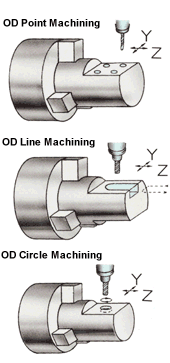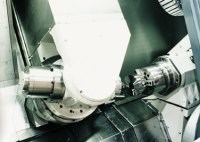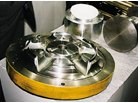Consider Milling On Your Turning Center
Most shops are looking to reduce throughput time. One sensible method is to eliminate multiple part handlings and work-in-process time. Advances in machine tool capability and programmability enable more job shops and general-purpose manufacturers to take advantage of turn/mill machines. Here's a look at the state-of-the-art.
Share




Why should shops consider turn/mill as part of the production mix? After all, stand-alone machining centers and turning centers are basic components of a shop's manufacturing capacity. With just a lathe, a mill and a garage, you can be in business.
Actually machines that combine machining operations on a single platform are not as unusual as many might think. Most shops already use such a machine tool every day. By far the most successful example of combining metalworking process technology is the CNC machining center. Prior to its development, specific machines performed specific operations. Milling machines milled, drilling machines drilled, tapping machines tapped.
Workpieces requiring different operations moved from machine to machine. Each step required orientation, tramming and re-clamping of the workpiece. It all took time.
In this article we'll look at the next step in process combination, adding milling, drilling and tapping capability to the turning operation. It's not new but it's evolving very fast. More capable machines with reduced price differentials combined with programming software dedicated to the turn/mill process are creating what is really a new class of machine tool and one that has a wider appeal than ever before. Here's a snapshot of where the technology is today. Perhaps it's time for your shop to jump on board.
Turn/Mill Basics
The most basic combination turn/mill machine uses a driven rotary cutter that is mounted in one or more tool pockets on the turning center turret. Linear axis movement of the rotary tool imitates that of the turning tool. Different attachments such as right angle heads allow longitudinal cutting along the X-axis while straight heads do the face work following the Z-axis travel. These tools generally run perpendicular to the workpiece surface being cut.
On these machines, any milling or drilling off the machine's center line is not possible because of the two-axis limit of the CNC turning center. But for simple slots or drilling and tapping operations, this level of turn/mill technology is quite adequate.
As for the rotary C-axis or spindle, it is generally an orientation-only axis on these basic machines. A coupling or other device inhibits rotation while milling, drilling or tapping operations are performed.
The next level of sophistication is to add servo-controlled actuation of the rotary C-axis. This is a common feature available on many turn/mill machine tools. Often a secondary motor is used to drive the spindle for contouring cuts. The main spindle motor would be disconnected in this case. In combination with the live tooling on the turning center turret, the C axis adds the ability to make spiral-milling cuts, contours or other relatively complex interpolated geometries.
Many builders enhance the productivity of turn/mill machines with the addition of a secondary or subspindle. This is usually mounted on its own set of slides, on center line with the main spindle, and it has the ability to pick off a workpiece from the main spindle. Here a shop starts really seeing some production benefits because secondary operations can be performed without operator intervention.
The addition of Y-axis to the turn/mill center adds what is truly machining center capability to the rotary tool option on a turning center. With the X, Z, C and Y axes, off center line geometric features can be machined. The ability to interpolate any or all of these axes makes manufacture of complex workpieces in a single setup not only possible, but in many cases, preferable to other process options.
However, as flexible and capable as these machines are, turn/mill technology has moved even further away from what is still fundamentally live tools on a turning center. For example, the turret configuration on the traditional turn/mill machine is a limiting factor for complex part processing. There are a limited number of positions available around the periphery of the disc.
Because rotary tools and turning tools are needed for turn/mill, compromises must be made about how many of each can be used. This sometimes results in shops relegating simpler geometric shapes to the turn/mill machine due primarily to a lack of tool capacity.
There are some builders who have approached turn/mill with different ideas about how best to design machines for performing combinations of operations. One of the leaders in this push toward what is called multi-tasking is Mazak Corporation (Florence, Kentucky). We talked to them about the state-of-the-art in turn/mill machine tools.
A New Kind Of Machine Tool
The current generation of turn/mill machines represents a design departure from the traditional turning center turret with live tools. In Mazak's line, these highly evolved machines are called Integrex. A few other builders have developed similar concepts.
The defining feature of this design is elimination of the tool turret. In its place is a single toolholder that provides milling, drilling and tapping capability along with turning, facing, grooving and threading.
The single tool turret is serviced by an automatic toolchanger that resides outside the cutting zone. Tool interchange times can be as low as 1.3 seconds. Toolholding capacity can be 80 tools. This greatly extends capacity to machine complex workpieces.
According to Tom Karnes, applications engineer at Mazak, "one of our problems is trying to find a term that describes this new class of machine tool. With four-axis milling, 10 horsepower, 10,000-rpm rotary spindle and a large capacity toolchanger, these new machines are every bit as much a machining center as a turning center."
On the company's large, single turret machines, the orientation can be linear or radial. The spindle carrier indexes to position the rotating or turning tool normal to the workpiece.
On their smallest Integrex model (200SY), the cutting tool spindle (B-axis) actually pivots through 225 degrees in 0.001-degree increments to allow angular drilling on the workpieces. The total travel of the B-axis spindle is sufficient enough to allow back-turning and milling operations to be performed on multi-axis work that is held in a synchronized pick-off subspindle.
A Different Way To Think
Mazak and other builders of highly evolved multi-tasking machines educate shops to look differently at how workpieces can be processed. "In the early days of live tools and turning centers," says Mr. Karnes, "most of the applications for these machines were heavily skewed to turning operations and a little milling. Rotary tools were generally underpowered and axis travel rates were slow compared to a stand-alone machining center. That's simply not true today."
The milling capability of machine tools like Integrex are equal to stand-alone machining centers. "It's not just an add-on anymore," says Mr. Karnes. "In many of the applications we see today, the turning portion of the work is significantly less than the machining. And in some applications, the tolerance specification is so tight that it would be very difficult to machine it with any more than just a single part handling."
The mindset that needs to be overcome involves separation of operations. Multi-tasking is no longer defined by how much milling versus how much turning. Rather, the question is one of total throughput time for producing a workpiece. The single setup cutting capability of the latest generation of turn/mill machines necessitates virtually no performance compromise to a sequentially used stand-alone turning center and machining center. Even the productivity of machining centers and turning centers in cellular arrangements can be met and often exceeded by automation of turn/mill machines with gantry loaders or other automatic material handling units.
According to Mr. Karnes, "if a shop is doing secondary operations that involve a turning center and machining center—in virtually any degree—odds are good that substantial throughput time could be realized by implementing turn/mill technology. Increasing throughput is the bottom line for multi-tasking."
And, that can affect your shop's bottom line in dramatic fashion.
Read Next
Building Out a Foundation for Student Machinists
Autodesk and Haas have teamed up to produce an introductory course for students that covers the basics of CAD, CAM and CNC while providing them with a portfolio part.
Read MoreSetting Up the Building Blocks for a Digital Factory
Woodward Inc. spent over a year developing an API to connect machines to its digital factory. Caron Engineering’s MiConnect has cut most of this process while also granting the shop greater access to machine information.
Read More
















.gif;width=860)























.jpg;maxWidth=970;quality=90)